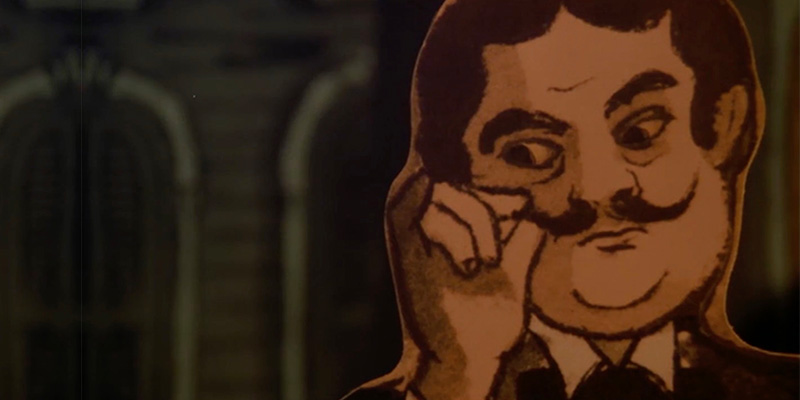The great artist Charles Addams, whose masterful cartoons and illustrations bedeviled the pages of The New Yorker from 1932 to 1988, drew two movie title sequences in his lifetime. He, the creator of the characters known as “the Addams Family” and a known master of the lighthearted-macabre, was tapped to provide illustrations for the opening to the 1963 horror-comedy The Old Dark House (which was a remake of the 1932 James Whale film The Old Dark House). More than a decade later, in 1976, he was recruited to illustrate a title sequence for the film Murder by Death.
This sequence was being designed by Wayne Fitzgerald, one of the twentieth-century’s greatest and most prolific credits designers (for movies as well as television). Fitzgerald, who directed the openings to everything from Bonnie and Clyde to The Conversation to Chinatown to Columbo, deserves to be remembered for his masterful title-work alongside Saul Bass (who designed the openings of many Hitchcock films, including North by Northwest and Otto Preminger’s Anatomy of a Murder ) and Friz Freleng (who designed the Pink Panther).
In the film, which is a parody of the traditional manor-house murder mystery, five different famous sleuths and their sidekicks are invited to a mansion by a mysterious host for “dinner and a murder,” and a night of red herrings, parlor tricks, hijinks, and skulduggery ensues. Lots of smoke, even more mirrors, some cloaks and a lot of daggers. If it sounds like Clue (1985), it’s because it is Clue‘s cantankerous, irreverent forefather.
Here, Fitzgerald’s direction exists as a tour of Addams’s illustrations. In the beginning of the film, a white-gloved hand opens a trunk to reveal a pop-up illustration featuring miniature caricatures of the entire cast. As the paintings in the film’s manor house location do, the figures’ eyeballs move back and forth suspiciously, while the humorously mysterious main theme plays. There are close-ups of each actor’s caricature long enough to marvel at Addams’s skill and sense of humor.
Here it is:
Now, if this wonderful title sequence is inspiring you to actually watch Murder By Death or it seems like my discussion of it is an endorsement of that film (it’s not)… please heed the following word of caution!
This isn’t an essay breaking down Murder By Death, by any means, but while I’m here I should mention a few important details about it. The thing about Murder By Death is that it is, conceptually, a perfect send-up of the whodunnit, and in the process of exaggerating, highlighting, and spoofing every aspect of the genre, it becomes both incredibly funny in some places and soberingly, upsettingly offensive in many others. It did not have to be that way! A few major revisions and we would have had a timeless comedy on our hands. The script was written by Neil Simon. The evening’s host is played by Truman Capote.
Capote’s character, Lionel Twain, is determined to prove that he is smarter than the world’s greatest detectives. “You’ve tricked and fooled your readers for years,” he yells. “You’ve tortured us all with surprise endings that made no sense. You’ve introduced characters in the last five pages that were never in the book before. You’ve withheld clues and information that made it impossible for us to guess who did it. But now, the tables are turned. Millions of angry mystery readers are now getting their revenge.”
The detectives are all versions of popular fictional characters, mostly played by soulmate-match-level character actors. The daffy spinster detective Miss Marbles (Miss Marple) is played by Elsa Lanchester. Uptight Belgian detective Milo Perrier (Hercule Poirot) is played by James Coco. The hard-drinking Dickie and Dora Charleston (Nick and Nora Charles, accompanied by an Asta-esque fox terrier named Myron), are played by David Niven and Maggie Smith. Tough-talking American PI Sam Diamond (Sam Spade) is played by Peter Falk. He brings with him an Effie Perine-esque secretary named Tess Skeffington (Eileen Brennan, who, in case you were wondering, also played Mrs. Peacock in Clue).
Here’s where things start to sour. The final detective in the group is Inspector Sidney Wang, and he is a spoof of Charlie Chan, the Chinese/Hawaiian police detective created by the white author Earl Derr Biggers. The history of Charlie Chan is very complicated and I will say upfront that I am not the one who should explain it. The gist is that he was created in part to counteract the rampant Anti-Asian sentiment infecting early 20th century America, but also wound up reinforcing a host of demeaning, problematic, Orientalist prejudices anyway. And the character appeared in many films in the 30s and 40s, always played by white men in Yellowface.
And so, Murder by Death chooses to satirize the history and presentation of the character, featuring Sidney Wang played in yellowface by Peter Sellers. This element makes so much of the film almost unwatchably unpleasant, and adds layers of racism onto an already fraught and derogatory tradition, especially because of its intentions to satirize. (Also important to address is the cringy, bad-taste design of the film’s disabled side characters, a blind butler played by Alex Guinness and a deaf-mute-illiterate maid played by Nancy Walker, whose difficulty communicating with one another, as well as disorientation in navigating the whole affair, is played for laughs.)
This piece is not a plea to watch or enjoy Murder by Death despite its evident racism or ableism. As with so many movies and books that traffic in insulting stereotypes while in other ways functioning as interesting pieces of art, like, say, Gone with the Wind, if you want to watch it, you should learn about its whole deal before you do and be prepared to engage with all parts of it.
As we go along, taking in stories that participate in the crime genres, it is extremely important not to forget all the insidious stuff that these genres excused, relied on, and exploited as they developed to our current moment. For further reading on Orientalism in crime fiction, check out Pooja Makhijani’s rundown of the history of Asian-American detective fiction, or this bibliography on critical approaches to Charlie Chan and his legacy. You should also check out Jessica Hagedorn’s anthologies of Asian-American writing, Charlie Chan is Dead (1993) and Charlie Chan is Dead 2 (2004).
But the point of this article is far more simple than “what do we do with Murder by Death?” The point of this article is to say that Murder by Death has extremely special title design. If only Wayne Fitzgerald and Charles Addams could have collaborated on another sequence.

















